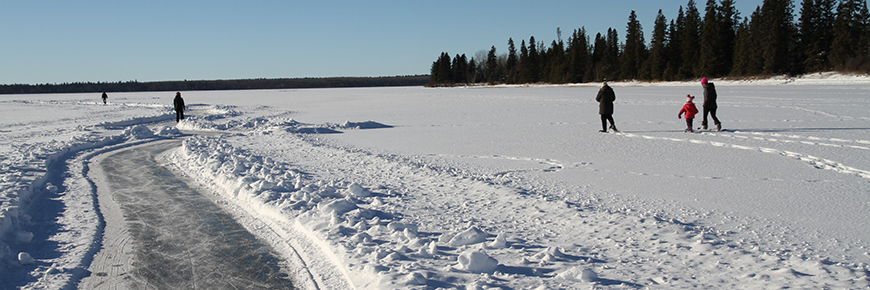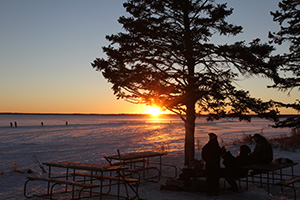
Winter Visitor Safety
Riding Mountain National Park
In order to make the most of your outing and avoid any unpleasant incidents, here are a few guidelines to follow:
Plan your outing around the weather forecast, snow conditions, and the distance you will be travelling. Travel in groups of at least three people.
Plan to get back before nightfall.
Inform someone of your itinerary.
- Obtain weather forecasts.
- Clothing for environmental conditions, including sunglasses and sunscreen.
- Ski within level of ability; maintain an adequate level of fitness and physical conditioning.
- Carry adequate food and water.
- Be familiar with the area and any local hazards; travel in three or more especially on overnight or extended trips.
- Maintain awareness of local snow and ice conditions.
- Know your limitations and periodically assess condition of others especially with regards to cold, dehydration, and exhaustion.
Make sure you’re equipped to survive several hours in the cold. In case of an emergency situation, here is a list of suggested items:
- A warm change of clothing
- Flashlight and extra batteries
- Fire-starting kit
- Whistle
- First aid kit
- Survival shelter
- Pocket-knife
- Orientation and communication kit (park map, compass, GPS, cellular phone, etc.)
- Enough food and water
- Snowshoes and/or cross-country skiis

Hypothermia
Hypothermia occurs when the body loses heat faster than it can produce it. The usual causes of hypothermia are a combination of cold, damp, wind and exhaustion. Most cases develop in air temperatures between -1° C and 10° C. Treatment of hypothermia involves supplying heat to the victim.
Prevention is the best option:
- Avoid exposure,
- Stay dry, and beware of chilling wind,
- Use warm clothing and good rain gear (wool and some synthetic clothing insulates when wet),
- Change damp undergarments,
- Avoid overheating in order to prevent excessive perspiring with resultant energy loss,
- Eat foods high in fats and carbohydrates,
- Make camp before exhaustion sets in.
Learn how to identify hazardous ice and plan safe travel routes on ice.
Traveling over ice:
- Continually assess ice condition as appropriate to season and local conditions.
- Avoid areas of overflow, rapidly flowing water, open leads, pressure ridges, flow edge.
- Carry extra clothing and emergency kit (even on day trips).
- When walking on glare ice, one should use traction aids on footwear.
For further information consult Red Cross and Lifesaving Society

You are responsible for your own safety. Parks Canada can help you prepare by assisting you with trip planning, and providing you with information.
The natural environment can be hazardous if you are not prepared. Trip planning means thinking about possible factors that could compromise your comfort and safety, and making the appropriate adjustments in gear, time allocations, and expectations. It means being ready for the unexpected.
Responsibility of Visitors
Visitors are expected to plan and prepare for their trip before they leave home. Travelers in all seasons should be self reliant and fully prepared to deal with any mishaps which may arise on their outings.
To do this, they must:
- recognize the risk inherent in their activities and ensure that they have the knowledge, skills and physical fitness to participate.
- get trained, be properly equipped, and be prepared to survive until help arrives.
- seek and heed advice from Parks Canada staff concerning risks and hazards, and how to prepare for them.
- observe and adhere to regulations, fencing, barriers, and signs.
- Be aware of surroundings (i.e. wildlife encounters, hazardous terrain) at all times and avoid areas where the potential for injury is high.
- Ensure that you are familiar with any equipment/gear being used.
- Be aware of the local area.
Trip Planning Tools
AdventureSmart, a national program dedicated to encouraging Canadians and visitors to Canada to “Get informed and go outdoors.”
Important Contact Numbers
Emergency (police, fire, ambulance) 911
Parks Canada Dispatch 1-877-852-3100
- Date modified :